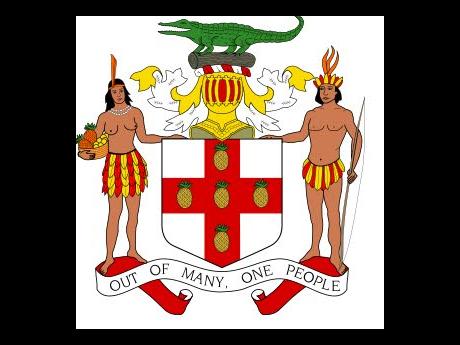The story of the Jamaican symbols
JAMAICA, LIKE most sovereign territories, has national emblems that represent our autonomy, history, and culture. Some people hold them dear to their hearts, but to others, they are meaningless for a variety of reasons. We are not at all patriots.
Nonetheless, before the manifestation of our coat of arms, motto, flag, and national song, there is a story that is seldom told, if any at all. We repeat the motto, wave the flag every chance we get, and sing the anthem lustily, even vocalising the “Boom!”, but many of each do not know their individual story.
So for those who do not know, we are starting with the coat of arms. The people represented on it are the Tainos, who were living here when the Spaniards chanced upon them in 1494. They were almost wiped out by European diseases and hard labour. Many survived in the hills and mountains, where they interbreed with the enslaved Africans who ran away from the plantations
The British invaded and occupied Jamaica in 1655. The first coat of arms was granted to Jamaica in 1661 under a royal warrant. The original was designed by William Sancroft, then Archbishop of Canterbury. The original motto, Indus Unterque ServietVni, is the Latin translation for ‘The two Indians will serve as one’, or ‘Both Indies will serve together’, in reference to the collective servitude of the Tainos to the colonisers.
The design was changed a few times, including in 1906, 1957, and 1962. The motto was replaced in 1962 with ‘Out of Many, One People’, in tribute to the unity of the different ethnic groups on the island, whose flag is one of the world’s most recognisable national symbols.
Political Independence
Its story started in September 1961 when a competition was announced for the design of a national flag since political Independence was expected the following year. Three hundred and eighty-eight entries were submitted. Twelve were selected, from which one was declared the winner by a joint parliamentary committee in June 1962.
It turned out that it was too similar to the flag of the African country then known as Tanganyika. The colours of black, green, and gold were kept, but the design was changed to what it is today. The new design was announced in the House of Representatives on June 20 by House leader Donald Sangster. It was approved by all of the House members.
On July 19, 1962, Jamaica’s House of Representatives unanimously approved the song that come to be known as the Jamaican national anthem. We were on the cusp of Independence, and such a song was needed by August 6 to commemorate this political milestone. Entries for submission were solicited.
One hundred people submitted, but none was found suitable. There was one written and set to music by Warrant Officer E.H. Wade, British-born bandmaster of the West India Regiment Band. It was agreed at an informal meeting that that song should have been submitted as the national anthem. However, it was rejected by the House.
Another one was selected and approved, but not without tension. The words were written by the Reverend Hugh Sherlock and the music composed by Robert Lightbourne, minister of trade and industry. It was arranged by Mapletoft Poulle, a Kingston solicitor and musician, and his wife.
The selection by the joint committee of the House of Representatives, headed by the Premier, Sir Alexander Bustamante, ended the tension surrounding it. At the sitting of the committee members of the House it was presented to them under not-so-good a condition when they heard it for the first time in the lounge of the House.
So before the sitting of the committee, members of both chambers listened to the songs at St George’s Church in Kingston. The police band, an organist, and singers were the performers. However, taking the listening from Parliament to a church did not sit well with Norman Manley, leader of the Opposition.
He said that “the procedure that took the matter of the anthem out of the hands of the House in formal session into other meetings was unfortunate and irregular”. Yet, he was happy with the one selected. So was Edward Seaga, minister of development and welfare and member of the joint committee, who said that the Government had proposed to put into effect a crash programme to popularise the anthem before August 6.
It is now 62 years since the ‘Black, Green, and Gold’ was raised at the National Stadium and the anthem first sung. Since then, Jamaica Land We love, a Christian prayer, and our national flag are easily recognised the world over mostly because of our prominence in sports and other endeavours.


